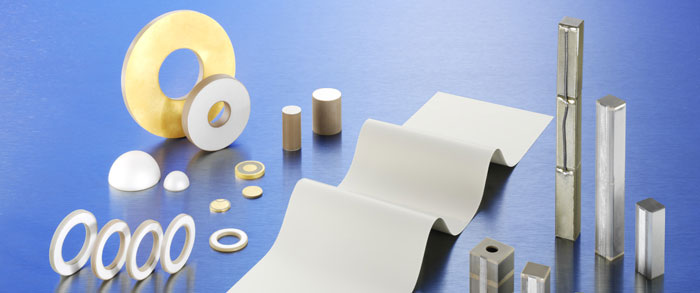压电陶瓷的生产工艺大致与普通陶瓷的生产工艺相似,但压电陶瓷的生产工艺有自己的特点,所以,在此以 PZT 即 Pb (Zr, Ti) O3系陶瓮为主,介绍压电陶瓷的必要工序及制作方法。压电陶瓷的主要工艺流程:
配料——球磨——过滤、干燥——预烧——二次球磨——过滤、干燥——过筛——成型
——排塑——烧结——精修——上电极——烧银——极化——测试。
1.原料处理
首先,根据化学反应式配料。所用的原料大多为金属氧化物,少数也可用碳酸盐(预烧时便分解为氧化物)。为使生成压电陶瓷的化学反应顺利进行,要求原料细度一不超过2 μm(平均直径)。提高原料纯度,有利于提高产品质量,但这个问题不是绝对的,使用纯度较低廉的原料,选择适当的工艺条件,同样可以生产出性能优良的产品。
通常使用转动球磨机或振动球磨机进行原料混合及粉碎。另外,在生产中往往还使用气流粉碎法,用高压气流的强力破碎作用,使粉料形成雾状,由于不用球石,可以避免杂质混入,而且效率提高。
预烧中的反应过程:预烧过程一般须经过四个阶段:线性膨胀(室温~400℃) , 固相反应(400~750℃) ,收缩(750~850℃) 和晶粒生长(800~900℃以上)。
2.成型和排塑
原料经预烧后,就合成了固溶体化合物。再经一次粉碎,便可成型。成型可根据不同的要求采用轧膜、压型或等静压等方式。成型之前需加入粘合剂。对轧膜的情况,粘合剂一般是粉料质量的15%~20%, 对压型的情况只需加5%左右。过多的粘合剂会使制品的致密度降低。成型后生坯中的粘合剂、水分等必须加温排去,称为排塑或排胶。
3.烧结
排塑后的生坯重新装炉烧结。影响烧结的因素很多,首先是配方的化学组成,当配方组成中有足够的活动离子时,烧结容易进行。例如,PZT中锆离子活动性差,所以 PZT 中锆含量增加,烧结温度升高,烧结困难。
添加物对改善压电陶瓷性能和压电陶瓷的烧结起很大作用。“软性”添加物的共同特点是
可以使陶瓷性能往“软”的方面变化,也就是提高弹性柔顺系数,降低机械品质因子Qm值,提高介电常数,增大介电损耗。由于“软性”添加物加入固溶体中时形成A位置空位,所以又称为产生A 空位添加物。由于烧结过程中形成了阳离子空位,从而大大加速离子扩散过程,促进压电陶瓷烧结。
“硬性”添加物是指进入A位置的K 、Na 以及进入B位置的Fe2 、Co2 、Mn2 、Ni2 、Mg2 等金属离子。“硬性”添加物的作用正好与“软性”添加物作用相反,能使压电陶瓷的性能向“硬”的方向发展,也就是说,使介电损耗降低,提高机械品质因子Qm值,提高介电常数。“硬性”添加物所起的作用是主作用,在晶格中,它引起氧空位,使晶胞产生收缩,降低扩散速度,因而使压电陶瓷难以烧结。
加人产生液相的添加物(如 MgO, MnO等), 可降低烧结温度,但烧结温度范围变窄。添加能限制晶粒长大的添加物(如 Fe3 , Al3 , Cr3 等), 可形成有限固溶体,随着烧结过程的进行,晶格缺陷得到矫正,溶解度降低,使得已固溶的添加物在晶界析出,形成第二相,可以起到抑制晶粒长大的作用,从而提高陶瓷的抗折强度。
压电陶瓷的烧成应在氧化气氛中进行。特别是组成中有La3 、Nb5 等添加物时,对它们烧结后往往还要进行氧化处理,以保证产生阳离子空位,使游离电子数目减少,提高压电性能。
压电陶瓷烧结过程中PbO的挥发对产品的质量影响很大。由于PbO挥发,破坏了配方的化学组成,导致Pb (Zr, Ti) O3的分解,出现非铁电相ZrO2, 使陶瓷内部气孔率增加,难以烧结。

压电陶瓷制品
4.上电极
烧成的陶瓷经精修、研磨、清洁后,就可以被覆上电极。被覆电极一般采用涂布银浆烘干,然后装炉,加热到750℃, 保温10~20min, 使银浆中的氧化银还原为银,并烧渗到陶瓷表面,形成牢固结合层。也可采用真空蒸镀或化学沉积等办法来被电极。被上电极的产品便可进行人工极化处理。
5.极化
压电陶瓷必须经过极化后才有压电性。极化就是在直流电场作用下使电畴沿电场方向取向。为使极化充分进行,应当提高极化场。极化电场大小主要取决于矫顽场强和饱和场
强。极化场强一定要大于矫顽场强,才能使电畴发生反转。但提高场强容易引起击穿,这
就限制了极化电场的提高。













